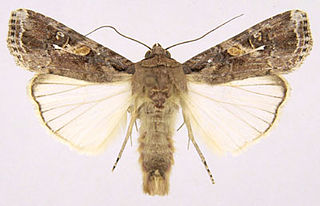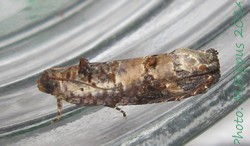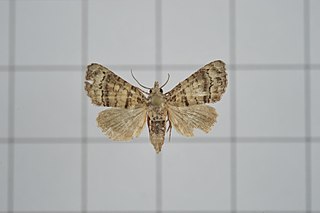Related Research Articles

The spiny oak slug is the larval form (caterpillar) of a moth in the family Limacodidae.

Nepita is a monotypic moth genus in the subfamily Arctiinae erected by Frederic Moore in 1860. Its only species, Nepita conferta, the footman moth, was first described by Francis Walker in 1854. It is found in India and Sri Lanka.

The fall armyworm is a species in the order Lepidoptera and one of the species of the fall armyworm moths distinguished by their larval life stage. The term "armyworm" can refer to several species, often describing the large-scale invasive behavior of the species' larval stage. It is regarded as a pest and can damage and destroy a wide variety of crops, which causes large economic damage. Its scientific name derives from frugiperda, which is Latin for lost fruit, named because of the species' ability to destroy crops. Because of its propensity for destruction, the fall armyworm's habits and possibilities for crop protection have been studied in depth. It is also a notable case for studying sympatric speciation, as it appears to be diverging into two species currently. Another remarkable trait of the larva is that they consistently practice cannibalism, despite its fitness costs.

Parasa lepida, the nettle caterpillar or blue-striped nettle grub, is a moth of the family Limacodidae that was described by Pieter Cramer in 1799. It is a native minor pest found in the Indo-Malayan region, including India, Sri Lanka, Vietnam, Malaysia and Indonesia. It is an introduced pest to urban trees in western Japan.

Dudua aprobola, the mango flower webworm or litchi leaf roller, is a moth of the family Tortricidae. The species was first described by Edward Meyrick in 1886. It is a pest on several economically important crops.

Maliarpha separatella, the African white stemborer, is a species of moth of the family Pyralidae. A worldwide paddy pest, it is found throughout African countries of Cameroon, Mali, Réunion, Madagascar, South Africa, and many Asian paddy cultivating countries such as Myanmar, India, and Sri Lanka. Though they are reported from China and Papua New Guinea, they are also known to attack sugarcane.
Biston suppressaria, the tea looper, is a moth of the family Geometridae. It is found in China, India, Myanmar, Nepal, and Sri Lanka.
The Coconut black headed caterpillar, is a species of moth found in throughout East Asian countries including Bangladesh, India, Sri Lanka, Myanmar, as well as Indonesia. It is considered a pest of coconut palm trees, causing considerable damage to the trees, and reducing the plant's yield significantly and can be a major problem where coconuts contribute to the economy. The species exists on coconut palms through its life stages from larval to moth, and utilizes the tree fronds as a main source of nutrition. Various methods of control have been explored, yet the primary control method is the administration of pesticides directly to the root of the coconut palms.
Opisina is a monotypic moth genus in the family Xyloryctidae described by Francis Walker in 1864. Its only species, Opisina arenosella, the coconut black-headed caterpillar, was described by the same author in the same year. It is found in India, Sri Lanka, Bangladesh and Myanmar.
Euproctis fraterna is a moth of the family Erebidae first described by Frederic Moore in 1883. It is found in the Maldives, India, Sri Lanka and the Seychelles.
Naranga diffusa, the rice green semilooper, is a moth of the family Noctuidae. The species was first described by Francis Walker in 1865. It is found in many agricultural based countries such as Bangladesh, India, Sri Lanka, China, Hong Kong, Iran, Japan, the Korean Peninsula, Malaysia, Myanmar, the Philippines, Thailand, Taiwan and Vietnam.

Chlumetia transversa, the mango shoot borer, is a moth of the family Euteliidae. The species was first described by Francis Walker in 1863. It is a widely distributed across Indo-Australian tropical countries far east to Solomon Islands.
Spatulifimbria castaneiceps is a moth of the family Limacodidae first described by George Hampson in 1892. It is found in Sri Lanka, Hong Kong and Taiwan.
Scopelodes venosa is a moth of the family Limacodidae first described by Francis Walker in 1855. It is found in Sri Lanka, China, India, northern Myanmar, northern Thailand, northern Laos, Vietnam and Nepal.
Altha adala is a moth of the family Limacodidae first described by Frederic Moore in 1859. It is found in Sri Lanka, India, Thailand, Myanmar, Vietnam, Java, Bali, Borneo, and Sumatra.
Miresa albipuncta is a moth of the family Limacodidae first described by Gottlieb August Wilhelm Herrich-Schäffer in 1854. It is found in Sri Lanka, India and Nepal.
Thosea aperiens, the stinging caterpillar, is a moth of the family Limacodidae. The species was first described by Francis Walker in 1865. It is found in Sri Lanka and India.

Parasa bicolor, the green rice moth, is a moth of the family Limacodidae. The species was first described by Francis Walker in 1855. It is found in Sri Lanka, India, Nepal, Pakistan, Myanmar, Laos, Taiwan, Vietnam, Malaysia, Java, China and Taiwan.

Pammene critica, the redgram webber or leaf webber, is a moth of the family Tortricidae. The species was first described by Edward Meyrick in 1905. It is found in India and Sri Lanka.
Selepa celtis, called the hairy caterpillar as a larva, is a moth of the family Nolidae. The species was first described by Frederic Moore in 1858. It is found in Oriental tropics of India, Sri Lanka, Taiwan towards the Ryukyu Islands and Australia.
References
- ↑ "Species Details: Macroplectra nararia Moore, 1859". Catalogue of Life. Retrieved 29 June 2018.
- ↑ Koçak, Ahmet Ömer & Kemal, Muhabbet (20 February 2012). "Preliminary list of the Lepidoptera of Sri Lanka". Cesa News. Centre for Entomological Studies Ankara (79): 1–57 – via Academia.
- ↑ "Insect Pest Management". AICRP (Palms). Retrieved 28 June 2018.
- ↑ "Pediobius imbrues (Hymenoptera: Eulophidae), a promising parasitoid of coconut slug caterpillar, Macroplectra nararia Moore (Lepidoptera: Limacodidae) in Andhra Pradesh". Pest Management in Horticultural Ecosystems. Retrieved 28 June 2018.